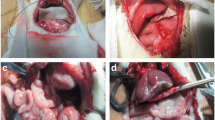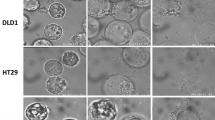Abstract
Background
Rupture of hepatocellular carcinoma (HCC) releases tumor cells and furthers peritoneal metastasis. The present study investigated the killing effects of distilled water (DW) on HCC cells and the clinical outcomes of patients undergoing liver resection with DW lavage for spontaneously ruptured HCC.
Materials and Methods
Human HCC cells (BEL-7402, SMMC7721) were treated with DW, the morphological changes observed, and cell viability measured. DW-treated HCC cells were also injected intraperitoneally into nude mice, and the formation of tumor nodules and overall survival (OS) measured. The clinicopathological data of 141 consecutive patients undergoing liver resection for spontaneously ruptured HCC during 1998–2011 were retrospectively reviewed.
Results
Fifteen minutes of DW exposure caused complete cell lysis of HCC cells in vitro and completely prevented tumor formation and prolonged survival time in nude mice. Among the 141 patients, the 1-, 3-, and 5-year disease-free survival (DFS) and OS rates in patients administered DW lavage during surgery were 68.9, 24.6, and 6.6 %, respectively, and 95.1, 65.1, and 40 %, respectively, which were significantly higher than those in patients who did not (P < 0.05). DW lavage was an independent predictor of recurrence (odds ratio (OR), 0.34; 95 % confidence interval (CI), 0.23–0.51; P < 0.001) and OS (OR, 0.35; 95 % CI, 0.23–0.53; P < 0.001).
Conclusions
Fifteen minutes of DW lavage can effectively kill HCC cells in vitro and prevent tumor formation in vivo. DW lavage significantly improves long-term outcomes in patients undergoing liver resection for spontaneously ruptured HCC and could be administered intra-operatively when tumor cell liberation is suspected.





Similar content being viewed by others
References
Bruix J, Sherman M. Management of hepatocellular carcinoma. Hepatology. 2005;42(5):1208–36.
Aoki T, Kokudo N, Matsuyama Y, Izumi N, Ichida T, Kudo M, et al. Prognostic impact of spontaneous tumor rupture in patients with hepatocellular carcinoma: an analysis of 1160 cases from a nationwide survey. Ann Surg. 2014;259(3):532–42.
Hsueh KC, Fan HL, Chen TW, Chan DC, Yu JC, Tsou SS, et al. Management of spontaneously ruptured hepatocellular carcinoma and hemoperitoneum manifested as acute abdomen in the emergency room. World J Surg. 2012;36(11):2670–6.
Fechner G, Pocha K, Schmidt D, Muller SC. Reducing recurrence and costs in superficial bladder cancer: preclinical evaluation of osmotic cytolysis by distilled water vs. mitomycin. International Journal of Clinical Practice. 2006;60(10):1178–80.
Takemoto K, Shiozaki A, Ichikawa D, Komatsu S, Konishi H, Nako Y, et al. Evaluation of the efficacy of peritoneal lavage with distilled water in colorectal cancer surgery: in vitro and in vivo study. Journal of Gastroenterology. 2014.
Chang YM, Hsu KF, Yu JC, Chan DC, Chen CJ, Chen TW, et al. Distilled water peritoneal lavage in patients with rupture hepatocellular carcinoma. Hepatogastroenterology. 2013;60(121):140–3.
Itano N, Atsumi F, Sawai T, Yamada Y, Miyaishi O, Senga T, et al. Abnormal accumulation of hyaluronan matrix diminishes contact inhibition of cell growth and promotes cell migration. Proceedings of the National Academy of Sciences of the United States of America. 2002;99(6):3609–14.
Zhu LX, Wang Gs Fau - Fan ST, Fan ST. Spontaneous rupture of hepatocellular carcinoma. (0007–1323 (Print)).
Liu CL, Fan ST, Lo CM, Tso WK, Poon RT, Lam CM, et al. Management of spontaneous rupture of hepatocellular carcinoma: single-center experience. Journal of Clinical Oncology: Official Journal of the American Society of Clinical Oncology. 2001;19(17):3725–32.
Miyoshi A, Kitahara K, Kohya N, Noshiro H, Miyazahi K. Outcomes of patients with spontaneous rupture of hepatocellular carcinoma. Hepatogastroenterology. 2011;58(105):99–102.
Chok KS, Cheung TT, Chan SC, Poon RT, Fan ST, Lo CM. Surgical outcomes in hepatocellular carcinoma patients with portal vein tumor thrombosis. World J Surg. 2014;38(2):490–6.
Oba A, Takahashi S, Kato Y, Gotohda N, Kinoshita T, Shibasaki H, et al. Usefulness of resection for hepatocellular carcinoma with macroscopic bile duct tumor thrombus. Anticancer Research. 2014;34(8):4367–72.
Park KG, Chetty U, Scott W, Miller W. The activity of locally applied cytotoxics to breast cancer cells in vitro. Annals of the Royal College of Surgeons of England. 1991;73(2):96–9.
Huguet EL, Keeling NJ. Distilled water peritoneal lavage after colorectal cancer surgery. Diseases of the Colon and Rectum. 2004;47(12):2114–9.
Kosuga T, Shiozaki A, Ichikawa D, Fujiwara H, Komatsu S, Iitaka D, et al. Pleural lavage with distilled water during surgery for esophageal squamous cell carcinoma. Oncology Reports. 2011;26(3):577–86.
Hai L, Yong-Hong P, Yong F, Ren-Feng L. One-stage liver resection for spontaneous rupture of hepatocellular carcinoma. World J Surg. 2005;29(10):1316–8.
Yeh CN, Chen MF, Lee WC, Jeng LB. Prognostic factors of hepatic resection for hepatocellular carcinoma with cirrhosis: univariate and multivariate analysis. Journal of Surgical Oncology. 2002;81(4):195–202.
Caplanusi A, Kim KJ, Lariviere E, Van Driessche W, Jans D. Swelling-activated K+ efflux and regulatory volume decrease efficiency in human bronchial epithelial cells. The Journal of Membrane Biology. 2006;214(1):33–41.
Shiozaki A, Ichikawa D, Takemoto K, Nako Y, Nakashima S, Shimizu H, et al. Efficacy of a hypotonic treatment for peritoneal dissemination from gastric cancer cells: an in vivo evaluation. BioMed Research International. 2014;2014:707089.
Yeh CN, Lee WC, Jeng LB, Chen MF, Yu MC. Spontaneous tumour rupture and prognosis in patients with hepatocellular carcinoma. British Journal of Surgery. 2002;89(9):1125–9.
Chiappa A, Zbar A, Audisio RA, Paties C, Bertani E, Staudacher C. Emergency liver resection for ruptured hepatocellular carcinoma complicating cirrhosis. Hepatogastroenterology. 1999;46(26):1145–50.
Yang T, Sun YF, Zhang J, Lau WY, Lai EC, Lu JH, et al. Partial hepatectomy for ruptured hepatocellular carcinoma. The British Journal of Surgery. 2013;100(8):1071–9.
Acknowledgments
This work was funded by the National Natural Science Foundation of China (No. 81172293) and allocated to Dr. Zhi-yong Huang.
Conflict of Interest
None.
Author information
Authors and Affiliations
Corresponding author
Electronic Supplementary Material
Below is the link to the electronic supplementary material.
Supplemental Fig. 1
Evaluation of the toxicity of the peritoneal injection of DW. Two milliliters of PBS or DW was injected into the abdominal cavities of 4-week-old male BALB/c nude mice. One week after injection, all mice were killed, and intra-abdominal findings were investigated (n = 3). a No significant differences were observed in the representative macroscopic findings of abdominal organs between the PBS and DW groups. b No significant differences were observed in the representative histological findings of the small intestine or liver between the PBS and DW groups (magnification, ×100). Peritoneal injection of DW did not cause toxicity in mice. PBS phosphate-buffered saline, DW distilled water. (GIF 90 kb)
Supplemental Fig. 2
Inhibition of the establishment of peritoneal dissemination after incubation of SMMC7721 cells with DW. a Representative macroscopic findings in the abdominal cavity. Arrows indicate disseminated nodules. b The mean size, number of disseminated nodules, and tumor incidence were significantly decreased by DW incubation. The OS was significantly worse in the PBS group than in the DW group (n = 10 per group, *P < 0.05; § P > 0.05). PBS phosphate-buffered saline, DW distilled water, OS overall survival. (GIF 81 kb)
Supplemental Fig. 3
Inhibition of the establishment of peritoneal dissemination of SMMC7721 cells by peritoneal injection of DW at the indicated time points. a Representative macroscopic findings in the abdominal cavity. Arrows indicate disseminated nodules. b The mean size, number of disseminated nodules, and tumor incidence were significantly decreased by peritoneal DW injection. The OS was significantly worse in the PBS group than in the DW group (n = 10 per group; *P < 0.05; § P > 0.05). PBS phosphate-buffered saline, DW distilled water, OS overall survival. (GIF 97 kb)
Supplemental Fig. 4
DW lavage improved long-term outcomes of patients in the emergency surgery group and staged surgery group. Comparison of DFS (a) and OS (b) rates between the DW and non-DW groups within the emergency surgery group. Comparison of DFS (c) and OS (d) rates between the DW and non-DW groups within the staged surgery group. (GIF 28 kb)
Rights and permissions
About this article
Cite this article
Zhou, Sj., Zhang, El., Liang, By. et al. Distilled Water Lavage During Surgery Improves Long-Term Outcomes of Patients with Ruptured Hepatocellular Carcinoma. J Gastrointest Surg 19, 1262–1270 (2015). https://doi.org/10.1007/s11605-015-2797-0
Received:
Accepted:
Published:
Issue Date:
DOI: https://doi.org/10.1007/s11605-015-2797-0




